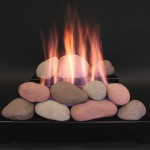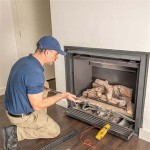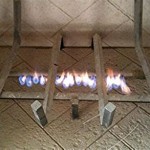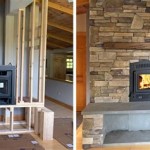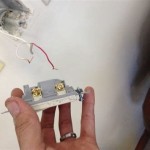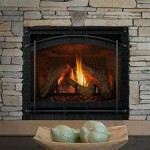How To Reface A Brick Fireplace With Stacked Stone
Refacing a brick fireplace with stacked stone is a popular home improvement project that can dramatically update the look of a living space. This process involves adhering manufactured or natural stone veneer to the existing brick surface, creating a more modern and visually appealing focal point. While this project can be undertaken by experienced DIYers, it requires careful planning, precision, and adherence to specific steps to ensure a durable and aesthetically pleasing result. A poorly executed installation can lead to costly repairs and a compromised appearance. Therefore, a thorough understanding of the materials, tools, and techniques involved is critical for a successful outcome.
Before embarking on the refacing project, several factors need to be considered. The structural integrity of the existing brick fireplace is paramount. Any cracks, crumbling mortar, or other signs of damage must be addressed before applying the stacked stone. A stable and sound substrate is essential for the long-term adhesion and stability of the new veneer. Also, the style and design of the stacked stone should complement the overall aesthetic of the room. Consider the color, texture, and size of the stones to ensure a cohesive and visually harmonious result. Finally, local building codes and regulations should be reviewed to determine if any permits are required for this type of renovation.
Preparing the Brick Fireplace Surface
The first and arguably most important step in refacing a brick fireplace with stacked stone is preparing the existing brick surface. This involves cleaning, repairing, and creating a suitable bonding surface for the stone veneer. Inadequate preparation can significantly reduce the lifespan of the installation and lead to the stone detaching over time.
Begin by thoroughly cleaning the brick surface. Remove any loose dust, dirt, soot, or other debris. A wire brush can be used to scrub away stubborn grime. For more persistent stains, a specialized brick cleaner or a solution of trisodium phosphate (TSP) can be applied, following the manufacturer's instructions carefully. Rinse the surface thoroughly with clean water and allow it to dry completely. This cleaning process is crucial for ensuring proper adhesion of the mortar to the brick.
Inspect the brickwork for any damage, such as cracks, loose bricks, or crumbling mortar joints. Repair any defects before proceeding. Small cracks can be filled with a masonry crack filler. Replace any loose or damaged bricks using fresh mortar. Remove any loose or deteriorated mortar from the joints using a chisel and hammer. Re-point the joints with new mortar, ensuring it is packed tightly and flush with the surrounding brickwork. Allow the mortar to cure completely before moving on to the next step. This ensures a solid and level surface for the stacked stone.
To enhance the adhesion of the mortar to the brick surface, it is recommended to apply a scratch coat. This is a thin layer of mortar that provides a textured surface for the stacked stone to grip. Mix a batch of thin-set mortar according to the manufacturer's instructions. Apply the mortar to the brick surface using a notched trowel, creating horizontal grooves in the mortar. This grooved surface will provide a mechanical key for the stacked stone. Allow the scratch coat to dry and cure completely before proceeding. The scratch coat acts as a bonding agent, ensuring a strong and lasting connection between the brick and the stacked stone.
If the brick surface is particularly smooth or non-porous, consider applying a bonding agent before the scratch coat. This will further improve the adhesion of the mortar. Choose a bonding agent specifically designed for use with masonry and mortar. Apply the bonding agent according to the manufacturer's instructions, ensuring an even and complete coating. Allow the bonding agent to dry completely before applying the scratch coat. This is an extra precautionary measure for surfaces with challenging adhesion properties.
Installing the Stacked Stone Veneer
Once the brick surface is properly prepared, the next step is to install the stacked stone veneer. This requires careful planning, precise cutting, and meticulous application of mortar. Achieving a natural and aesthetically pleasing look depends on the accurate placement and alignment of each stone.
Before starting the installation, dry-fit the stacked stone to determine the layout and arrangement. This involves placing the stones on the floor in front of the fireplace, mimicking the intended pattern on the wall. This allows you to visualize the final appearance and make any necessary adjustments before applying the mortar. Pay attention to the color variations and textures of the stones to create a balanced and harmonious look. Cut any stones that need to be trimmed to fit the dimensions of the fireplace. Use a wet saw with a diamond blade for clean and accurate cuts. Dry-fitting is a crucial step in minimizing waste and ensuring a visually appealing result.
Mix a batch of thin-set mortar according to the manufacturer's instructions. Use a mortar mixer or a drill with a mixing attachment to ensure a smooth and consistent consistency. Avoid adding too much water, as this can weaken the mortar. Apply a generous layer of mortar to the back of each stone and to the prepared brick surface. Use a notched trowel to create ridges in the mortar, which will improve the bond. Press the stone firmly into place, wiggling it slightly to ensure good contact with the mortar. Work from the bottom up, starting with the corner stones. Maintain consistent spacing between the stones, typically around 1/2 inch. Use shims or spacers if necessary to ensure uniform joints. Remove any excess mortar that oozes out from the joints. Wipe the surface of the stones clean with a damp sponge. Consistent mortar application and secure stone placement are essential for a durable and aesthetically pleasing installation.
Continue installing the stacked stone, row by row, until the entire fireplace is covered. Stagger the joints between the courses to create a more natural and visually appealing look. Avoid creating long, continuous vertical joints. Use stones of varying sizes and shapes to add visual interest. As you work, periodically check the level and plumb of the installation to ensure that the stones are aligned correctly. Use a level and shims to make any necessary adjustments. Pay close attention to the corners and edges of the fireplace, ensuring that the stones are cut and fitted precisely. Achieving precise cuts and consistent alignment is key to a professional-looking finish.
Once the stacked stone is installed, allow the mortar to cure completely before grouting the joints. The curing time will vary depending on the type of mortar and the ambient temperature and humidity. Refer to the manufacturer's instructions for specific curing times. After the mortar has cured, apply grout to the joints using a grout bag or a pointing trowel. Pack the grout tightly into the joints, ensuring that they are completely filled. Remove any excess grout from the surface of the stones using a sponge and a bucket of water. Wipe the stones clean, being careful not to remove too much grout from the joints. Allow the grout to dry completely before applying a sealer. Grouting the joints provides a finished look and helps to protect the installation from moisture and dirt.
Sealing and Finishing the Stacked Stone
Sealing the stacked stone is an important step in protecting it from moisture, stains, and fading. A good quality sealer will help to preserve the appearance of the stone and extend its lifespan. The finishing touches can further enhance the look of the fireplace and integrate it seamlessly into the surrounding space.
Choose a sealer specifically designed for use with natural or manufactured stone. There are two main types of sealers: penetrating sealers and surface sealers. Penetrating sealers soak into the stone and create a water-repellent barrier from within. Surface sealers form a protective film on the surface of the stone. Penetrating sealers are generally preferred for stacked stone fireplaces, as they maintain the natural look and texture of the stone. Apply the sealer according to the manufacturer's instructions, using a brush, roller, or sprayer. Ensure an even and complete coating, paying particular attention to the joints. Allow the sealer to dry completely before using the fireplace. Sealing the stacked stone is a preventative measure that helps to protect it from the elements and maintain its beauty for years to come.
Depending on the desired look, the stacked stone can be finished with a variety of techniques. One option is to apply a color enhancer, which will deepen the colors and accentuate the natural variations in the stone. Color enhancers are available in a range of shades, from subtle to dramatic. Another option is to apply a stone wax, which will add a subtle sheen to the surface of the stone. Stone wax can also help to protect the stone from scratches and scuffs. Experiment with different finishing techniques on a small, inconspicuous area of the fireplace before applying them to the entire surface. This will allow you to see how the finish will look and ensure that you are happy with the results. Finishing the stacked stone is an opportunity to customize the look of your fireplace and create a unique focal point in your living space.
After the stacked stone is sealed and finished, clean up the surrounding area and inspect the installation for any imperfections. Touch up any areas that need attention, such as chipped stones or uneven grout lines. Consider adding decorative elements to the fireplace, such as a mantel, fire tools, or artwork. These accessories can help to enhance the overall look of the fireplace and create a more inviting atmosphere. Regularly clean the stacked stone fireplace with a mild soap and water solution to remove dust and dirt. Avoid using harsh chemicals or abrasive cleaners, as these can damage the stone. A well-maintained stacked stone fireplace will provide years of enjoyment and add value to your home. Proper maintenance ensures the longevity and beauty of your newly refaced fireplace.

Reface A Fireplace With The Look Of Stone Or Brick Barron Designs

Reface A Fireplace With The Look Of Stone Or Brick Barron Designs

Faux Stone Panels For Fireplaces

Did You Know Can Cover Your Existing Brick Fireplace Makeover Home Stone Designs

Stone Fireplace Design And Remodel

Pin By Tarra Wills Efkarpidis On For The Home Brick Fireplace Remodel Stone

Thin Stone Veneers Make A Fireplace Update Easy

Thin Stone Veneers Make A Fireplace Update Easy

A Step By Guide To Fireplace Refacing Diy Family Handyman

Reface An Old Brick Fireplace With East West Classic Ledge Stone Instant Update Décor Interi Makeover Home

